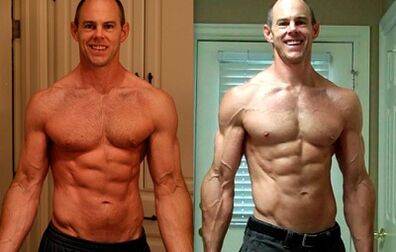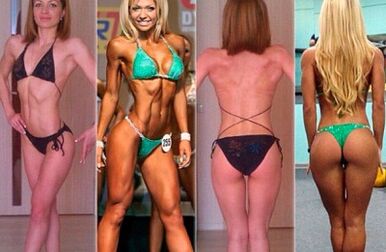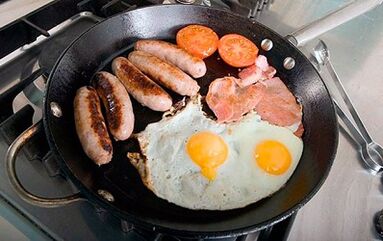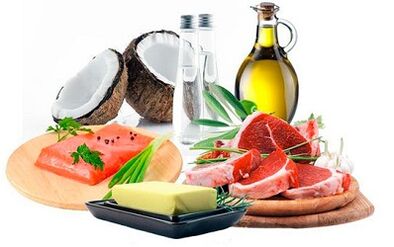
Many people who control their weight have noticed more than once that by giving up flour, sweets, potatoes and cereals for a short time, their weight quickly drops by a few kilograms.This is due to the rapid restriction of carbohydrates.Without receiving the usual daily dose of glucose, the body begins to look for other sources of energy and turns to fats and proteins.
Limitation of carbohydrate-containing foods is the main principle of the famous low-carbohydrate diet.But in addition to the sensational Kremlin diet and the Atkins diet, there is another stricter, but at the same time more effective nutritional system - the keto diet.
Keto diet, what is it?
The keto diet is a protein-fat diet with an almost complete lack of carbohydrates.This is one of the few diets known in our time that allows you to remove subcutaneous fat and maintain muscle mass.The main goal of the keto diet is to force the body to rapidly switch from glycolysis to lipolysis.Glycolysis is the process of breaking down carbohydrates and lipolysis is the process of breaking down fats.The latter is only triggered when the glycogen stores of the liver and muscle tissue are completely depleted, usually within a few days.During lipolysis, fats are broken down into free fatty acids and glycerol, which are then converted into ketone bodies.The process of the formation of ketone bodies is called ketosis, hence the name of the diet itself.
The body's adaptation to ketosis and the duration of the diet
Unlike the usual low-carb diet, the keto diet is longer and more systematic.In the first week, the body adapts to the changes by consuming reserves, and only closer to the second week does the burning of subcutaneous fat begin.
The body is prepared for ketosis in 4 stages:

- Total glucose consumption.In the first 12 hours after the last meal, the body uses glucose obtained from carbohydrates;
- Total glycogen consumption.Within 12 hours, the body can process all the glucose and begins to absorb glycogen reserves from the liver and muscles.This phase lasts about 1-2 days;
- Fat and protein consumption.This is the most difficult period, because after exhausting all carbohydrate reserves, the body begins to process not only fatty acids, but also tries to produce the necessary amount of glucose from protein.In this phase, the body tries to use protein as its main source of energy, including muscle protein;
- Ketosis, fat consumption.This stage occurs around day 7 of the diet.The body adapts to the lack of carbohydrates and ketosis begins.The breakdown of own and food proteins slows down, and fat eventually becomes the main source of energy.
The keto diet can last 2-3 weeks, depending on your goals.In the first week, the body processes the reserves and adapts to the new diet, and it is not until the second week that ketosis begins, so if you plan to cut back slightly and only spend a few days on it, the keto diet is not for you.In this case, it is better to choose a simpler and more frequent low-carb diet.It is very important to exit the keto diet correctly and gradually return to a normal diet, adding no more than 30 grams of carbohydrates per day.
For whom is the keto diet recommended and contraindicated?
To function properly, the human body needs three main nutrients: proteins, fats and carbohydrates.
They are found in common foods and each has its own function:
- Fats represent a kind of solid barrier of the internal organs, which also accumulates fats for cases of force majeure;
- Proteins are the main building blocks of muscles, joints and the whole body.Without it, you will never be able to pump up the muscles and build a beautiful, sculpted body.These organic substances are vital for professional athletes and all people with an active lifestyle;
- Carbohydrates are the main source of energy.They are the ones who give us life force and vitality.
Proteins, fats and carbohydrates are both useful and necessary when they enter the body in moderate, proportionate amounts.This is the reason why people who are active in sports and control their diet never have a problem with being overweight.But if a person leads a sedentary lifestyle, regularly overeats or eats chaotically, often eats junk food, sweets and other sweets, he provokes too much fat and carbohydrates in the body, which gradually turn into subcutaneous fat.The keto diet helps you get rid of excess weight and "cleanses" your body of excess fat.It will appeal to people who find it difficult to limit themselves in food and count calories.It is also indispensable for athletes during the drying period.Before starting this diet, it is important to consult a nutritionist and have a comprehensive examination of the body.The keto diet can give tangible positive results, but only if the person is healthy.
The keto diet is strictly prohibited for diabetics, pregnant women, thyroid patients, and those with kidney, liver, and gastrointestinal problems.
Pros and cons of the keto diet

Among the benefits of the keto diet is fast and effective weight loss.The number on the scale does not decrease due to fluid or muscle, but due to the breakdown of fat.There is no need to fast or constantly count calories during the keto diet.Of course, you have to control the amount of food you eat, but the keto diet is not based on calorie reduction, but rather on minimizing carbohydrate-containing foods as much as possible.As a result of the keto diet, you can get rid of fat while preserving muscle.
The main disadvantage of the keto diet is the lack of balance.Removing carbohydrates means reducing the amount of vitamins, beneficial microelements, and fiber, which are essential for cleansing the body and proper functioning of the stomach.The vitamin deficiency can be compensated for by consuming a vitamin complex at the end of the diet, but the situation is more complicated with fiber.Its deficiency can cause intestinal and kidney dysfunction, so it is recommended to eat fruits, vegetables, and bran in small quantities during the diet to minimize the risk of developing serious diseases.The main thing is not to overdo it and make sure that the amount of carbohydrates consumed per day does not exceed 50 g.
Limiting carbohydrates has a bad effect on mental and physical abilities, reduces activity and concentration.This is especially acute for people engaged in creative or intellectual activities.This period is often accompanied by increased fatigue, drowsiness and mild apathy.
What can and cannot be eaten during the keto diet?
During the keto diet, the majority of the diet should consist of protein-containing foods:
- Meat (beef, veal, rabbit, poultry and even pork);
- fish (especially herring, salmon, salmon, tuna);
- Seafood (mussels, shrimps, crabs, squid, etc.);
- Eggs (chicken and quail);
- Nuts (hazelnuts, almonds, pistachios);
- Skimmed milk 0.5 -1.5% fat;
- Low-fat fermented milk products (cottage cheese, yogurt, kefir) without dyes, flavors, fruit additives and sugar;
- Low-starch vegetables, salad and unsweetened fruits (sour apples, oranges, grapefruit) in limited quantities.
In order to compile the correct keto diet menu, it is important to know not only the allowed foods, but also the strictly prohibited foods:

- Bread;
- Potato;
- Cereals;
- Banana;
- Solo;
- Sugar;
- Chocolate;
- Confectionery (pasta, cakes);
- Any baked goods or homemade baked goods.
Based on these two lists and checking the energy table of the products, you can easily create a menu for a week, two weeks or even longer and stick to it.This energy table data will be needed to control carbohydrates.When writing the menu, make sure that their quantity does not exceed the 50g mark.daily.
Example menu
Morning.Omelet from two eggs with spinach, half a grapefruit, without tea sugar.
Dinner.A light version of homemade Caesar salad.It should consist of green salad leaves and cooked chicken breast.The salad can be poured with olive oil or lemon juice.You can't add the regular croutons or sauce in the recipe.
Dinner.Baked trout steak in foil.
Few people decide to try the keto diet, primarily because it breaks established stereotypes.Many people use the word "diet" to mean strict calorie counting, limiting fatty foods, meat, and transitioning to so-called "pasture."Whereas in the keto diet, everything is the exact opposite.Most fruits, vegetables, and grains are excluded from the diet, and eggs, seafood, fish, and meat, including fatty varieties, are included.






























